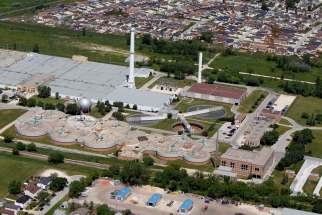Winnipeg sewage studied for coronavirus clues
Read this article for free:
or
Already have an account? Log in here »
To continue reading, please subscribe:
Monthly Digital Subscription
$0 for the first 4 weeks*
- Enjoy unlimited reading on winnipegfreepress.com
- Read the E-Edition, our digital replica newspaper
- Access News Break, our award-winning app
- Play interactive puzzles
*No charge for 4 weeks then price increases to the regular rate of $19.00 plus GST every four weeks. Offer available to new and qualified returning subscribers only. Cancel any time.
Monthly Digital Subscription
$4.75/week*
- Enjoy unlimited reading on winnipegfreepress.com
- Read the E-Edition, our digital replica newspaper
- Access News Break, our award-winning app
- Play interactive puzzles
*Billed as $19 plus GST every four weeks. Cancel any time.
To continue reading, please subscribe:
Add Free Press access to your Brandon Sun subscription for only an additional
$1 for the first 4 weeks*
*Your next subscription payment will increase by $1.00 and you will be charged $16.99 plus GST for four weeks. After four weeks, your payment will increase to $23.99 plus GST every four weeks.
Read unlimited articles for free today:
or
Already have an account? Log in here »
Hey there, time traveller!
This article was published 30/06/2020 (1989 days ago), so information in it may no longer be current.
Wastewater samples collected from three Winnipeg sewage treatment plants could exude new insights into the COVID-19 pandemic.
University of Manitoba environmental engineering Prof. Qiuyan Yuan is leading a team of scientists set to study city wastewater in an effort to better understand the prevalence of the novel coronavirus among residents.
“This is the starting point for us to realize the importance of monitoring the virus in wastewater,” Yuan told the Free Press. “Currently, many researchers all over the world are trying to estimate the volume of infection by using similar wastewater surveillance approaches.

“There are still no clear findings that such surveillance programs give the exact volume of infection. However, such programs can serve as an early warning tool for future outbreaks.”
The research team is waiting on safety approvals before starting the year-long project, but Yuan expects to begin in early July, and follow a protocol similar to one developed by the Netherlands-based KWR Watercycle Research Institute.
Yuan said wastewater and the effluent that flows from treatment plants may contribute to dissemination of SARS-CoV-2 — the virus that causes COVID-19 — in the environment. According to the KWR Watercycle Research Institute, the virus can be shed in feces but little is known about the infectious activity of coronavirus particles in sewage. However, it is not likely particles of the virus found in wastewater can infect people.
“To understand the fate of the virus in wastewater treatment plants, we are aiming to monitor the virus throughout wastewater treatment process and in treated wastewater,” Yuan said. The study will also examine whether the virus becomes aerosolized within treatment plants through normal processes, she said.
Every two weeks, samples of wastewater will be taken from the three treatment centres in Winnipeg and provided to Yuan’s team, including PhD student Kadir Yanac and U of M microbiology Prof. Miguel Uyaguari-Diaz, and his lab. The samples will be analyzed and data input into predictive models in an attempt to extrapolate for the general population, Yuan said.
“We will establish correlations between the number of cases and the concentration of coronavirus in the wastewater using data from wastewater treatment plants, population, and cumulative and active COVID-19 cases,” she said.
Municipalities across Canada are taking a closer look at the sewage treated at pollution control centres in an effort to predict possible outbreaks of COVID-19 and track how SARS-CoV-2 moves through the population, based on what’s being flushed down the toilet.
Researchers at the University of Calgary recently embarked on a similar study, and hope their analysis could identify neighbourhoods with pre-symptomatic cases of COVID-19. The study is in partnership with the Alberta Health Services and the City of Calgary.
Scientists in Calgary will also test sewage directly from the pipe, “closer to where people are flushing their toilets, in order to find neighbourhoods at risk,” according to a release. Wastewater monitoring is also happening in Ottawa, Gatineau, Que., and Vancouver and Surrey B.C., and in some European countries.
Yuan said researchers here intend to share their results with provincial public health officials. However, future arrangements haven’t yet been discussed.
Funding for the new research in Winnipeg was provided by the Natural Sciences and Engineering Research Council of Canada, in the amount of $50,000.
danielle.dasilva@freepress.mb.ca

Our newsroom depends on a growing audience of readers to power our journalism. If you are not a paid reader, please consider becoming a subscriber.
Our newsroom depends on its audience of readers to power our journalism. Thank you for your support.








